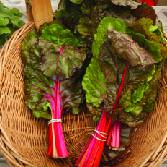-
CATEGORY ::
- All Seeds /
- All Flower Seeds /
- All Astilbe Seeds




Astilbe Seeds - Bunter
SEASON
Perennial
USDA ZONES
4 - 8
HEIGHT
28 inches
BLOOM SEASON
Summer
BLOOM COLOR
Mix
ENVIRONMENT
Partial shade
SOIL TYPE
Evenly moist soils are preferred, pH 5.5 - 6.8
DEER RESISTANT
Yes
HOUSE PLANT
No
SEASON
Perennial
USDA ZONES
4 - 8
HEIGHT
18 - 24 inches
BLOOM SEASON
Summer
BLOOM COLOR
Pink
ENVIRONMENT
Partial shade
SOIL TYPE
Well-drained, pH 5.8 - 6.8
DEER RESISTANT
Yes
HOUSE PLANT
No
SEASON
Perennial
USDA ZONES
3 - 8
HEIGHT
10 inches
BLOOM SEASON
Summer
BLOOM COLOR
Lilac-pink
ENVIRONMENT
Partial shade
SOIL TYPE
Well-drained, pH 5.8 - 6.8
DEER RESISTANT
Yes
HOUSE PLANT
No
About...
Astilbe (Astilbe Arendsii Bunter) - If you have shady areas that need some color, start some Astilbe seeds and brighten things up! What a variety of colors: violet, red, pink, cream and white as well as dark green, serrated foliage.
MORE ASTILBE OPTIONS
Planting Directions
TEMPERATURE
65 - 70F
AVERAGE GERM TIME
28 - 35 days
LIGHT REQUIRED
Yes
DEPTH
Do not cover
SOWING RATE
3 - 5 seeds per plant
MOISTURE
Keep moist until germination
PLANT SPACING
28 inches





Astilbe (Astilbe Arendsii Bunter) - If you have shady areas that need some color, start some Astilbe seeds and brighten things up! What a variety of colors: violet, red, pink, cream and white as well as dark green, serrated foliage. It's a shade lover that makes a nice cut flower for fresh or dried bouquets! Astilbe Arendsii is perfect for the shady bed or border. It is also both deer and rabbit resistant!
Common Questions
Can I grow astilbe in a container?
Yes, astilbe is fine for containers. Be sure to use a commercial potting mix and do not allow it to dry out.
Is astilbe deer resistant?
Yes, astilbe tends to be resistant to deer and rabbits.
What are some good plants to combine with astilbe?
Astilbe looks great with other shade loving perennials such as heuchera and hosta, which contrast with its ferny foliage.
Can I grow astilbe under a black walnut tree?
Astilbe is more resistant than other plants under a black walnut, but if planted too close to it the area may be too dry.
Does astilbe attract pollinators?
Yes, astilbe attracts bees, butterflies and moths.
Planting Directions
TEMPERATURE
65 - 70F
AVERAGE GERM TIME
28 - 35 days
LIGHT REQUIRED
Yes
DEPTH
Do not cover
SOWING RATE
10 - 12 seeds per plant
MOISTURE
Keep moist until germination
PLANT SPACING
12 inches





Astilbe (Astilbe Chinensis) - Growing Astilbe seeds is a wonderful way to liven up shady areas with plumes of color. Astilbe Chinensis is the gardener's best friend for breaking up the monotony of various shades of green in the shady garden. Astilbe plants are strong, robust shade-lovers that produce extremely large pink plumes. They are quite tall plants, averaging around twelve to eighteen inches in total without flowers and with flowers they can grow as tall as 2 feet.
Common Questions
Can I grow astilbe in a container?
Yes, astilbe is fine for containers. Be sure to use a commercial potting mix and do not allow it to dry out.
Is astilbe deer resistant?
Yes, astilbe tends to be resistant to deer and rabbits.
What are some good plants to combine with astilbe?
Astilbe looks great with other shade loving perennials such as heuchera and hosta, which contrast with its ferny foliage.
Can I grow astilbe under a black walnut tree?
Astilbe is more resistant than other plants under a black walnut, but if planted too close to it the area may be too dry.
Does astilbe attract pollinators?
Yes, astilbe attracts bees, butterflies and moths.
Planting Directions
TEMPERATURE
65 - 70F
AVERAGE GERM TIME
28 - 35 days
LIGHT REQUIRED
Yes
DEPTH
Do not cover
SOWING RATE
Approximated 1000 seeds covers 20 sq. feet or 10-12 seeds per plant
MOISTURE
Keep moist until germination
PLANT SPACING
12 inches





Astilbe (Astilbe Chinensis Pumila) - Pumila Astilbe Chinensis flower seed produces the most versatile Astilbe we know! It creates a wonderful ground cover for moist, shaded areas and is more tolerant of heat and temporary drought than other Astilbe plants. The foliage is a bronze-green color, and is topped with petite, rosy-pink plumes. Astilbe perennials are clump-forming and feature graceful, fern-like mounds of lovely foliage with plume-like flower panicles rising above the foliage on slender, upright stems.
Astilbe Pumila prefers a moist soil; however, it does tolerate dryness better than others. Astilbe seeds grow easily and soon there will be some wonderful color for the shade garden. Blooms begin in midsummer and continue until fall. Astilbe flower seeds are usually sown indoors in early spring and transplanted outside when the weather is warmer. Use a loose, soft soil mix, and plant the Astilbe flower seeds on the surface, pressing them into the soil. Make sure that the soil drains well and is able to keep the flower seeds moist, but not wet, at all times. For the best results, add in a little fertilizer that has a high concentration of nitrogen. Keep the Astilbe plants inside until the seedlings reach about 2 inches in height. Transplant after last frost.































